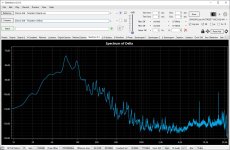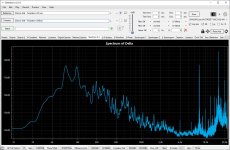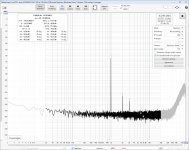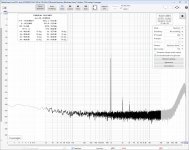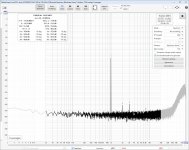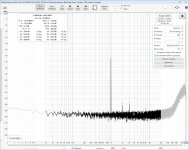How were PCM2DSD v03 and v04 made into files? Digitally, or via DAC->ADC? Somehow they were converted to PCM for comparison? Then comparison by FFT analysis?
Last edited:
DeltaWave works with recordings so DAC->ADC->DeltaWave. DeltaWave has a multitude of different types of analysis (see https://deltaw.org/). Most important ones are related to timing and phase which means that for most accurate results DAC and ADC need to be synchronized. DeltaWave is a tool for analysing implementation quality but not so much for comparisons. But for these types of scenarios where only a single variable is changed the results are quite indicative.
Is it this: PCM2DSD->Reclock/isolate?->Marcel DSD FIRDAC ->ESS ADC PCM_out ->PCM file (done with DAC and ADC on same clock) ....for each FPGA version? Then compare the two files in DeltaWave?
Also, may I ask if the two versions of FPGA code sounded different to begin with, as described here in this thread by others, and as verification of accurate playback of the DSD dac?
Then were the PCM files played back to verify they accurately sound like the DSD dac sounded for each FPGA version, as verification of the data conversion process accuracy?
Or maybe some other methodology was used to verify accuracy of the test equipment / measurement apparatus.
Because if the the experiment is truly an accurate analysis, then the assumption that the differences are below audibility is almost certainly wrong.
Also, may I ask if the two versions of FPGA code sounded different to begin with, as described here in this thread by others, and as verification of accurate playback of the DSD dac?
Then were the PCM files played back to verify they accurately sound like the DSD dac sounded for each FPGA version, as verification of the data conversion process accuracy?
Or maybe some other methodology was used to verify accuracy of the test equipment / measurement apparatus.
Because if the the experiment is truly an accurate analysis, then the assumption that the differences are below audibility is almost certainly wrong.
Last edited:
Yes.
Here are examples based on v03 and v04.
Here are examples based on v03 and v04.
- V03 Difference from the original.
- V04 Difference from the original
- Difference between v03 and v04
Attachments
Okay, I see a problem, which is that FFT spectra do not show phase. However, dynamics and transient response is very dependent on phase. As Marcel has pointed out, phase can be the only difference between smooth white noise and a Dirac impulse function. Yet the frequency spectra are the same for both: flat.
Also if the above frequency spectra are calibrated, it looks the difference has an amplitude down about -29dB from the inputs for LF and with some larger amplitude of differences at HF?
Also if the above frequency spectra are calibrated, it looks the difference has an amplitude down about -29dB from the inputs for LF and with some larger amplitude of differences at HF?
Last edited:
Today I tested Marcel's LC+MFB filter from post #3028 with OPA1632 as opamp. To my surprise "harmonics" at -60dBFS did not improve at all. Different versions of PCM2DSD work exactly the same as before (v03 having splitted peaks and v04 without).
I also tested the difference of PCM2DSD v03 and v04 with DeltaWave audio null comparator. The difference was very small and by all accounts below audibility. Actually the difference between v03 & v04 was much smaller than e.g. between ESS/AKM dac vs. RTZ dac.
In posts #2472 ( https://www.diyaudio.com/community/threads/return-to-zero-shift-register-firdac.379406/post-7635721 ) up to and including #2475, you posted very different 1 kHz, -60 dB distortion results for four different filters, see the attachments.
Stock: largest peak at or around the 2nd harmonic about -62 dB with respect to the fundamental, 3rd about -70 dB
Thor-like, but without passive filter: 2nd -68 dB, 3rd -76 dB
OPA1632 and OPA1632: 2nd -77 dB, 3rd -76 dB
OPA1632 and OPA1678: 2nd -77 dB, 3rd -76 dB
Unfortunately, it was all with HQPlayer ASDM7EC-light rather than with PCM2DSD v03. How does the LC+MFB filter with OPA1632 perform on this ASDM7EC-light test?
The spectum with the original filter and the PCM2DSD v03 looks very different, see post #2468.
Attachments
As I said those were just examples. It is possible to analyse phase or timing differences with DeltaWave as well. All analysis show minimal to non-existing difference between v03 and v04.Okay, I see a problem, which is that FFT spectra do not show phase.
E.g. here is phase difference between v03 and v04.
Attachments
Last edited:
I only tested PCM2DSD so to be precise: no improvement with PCM2DSD at 1kHz -60dBFS.In posts #2472 ( https://www.diyaudio.com/community/threads/return-to-zero-shift-register-firdac.379406/post-7635721 ) up to and including #2475, you posted very different 1 kHz, -60 dB distortion results for four different filters, see the attachments.
How was it verified that FPGA versions sounded different? Do you have any ABX scores?Also, may I ask if the two versions of FPGA code sounded different to begin with, as described here in this thread by others, and as verification of accurate playback of the DSD dac?
DeltaWave is able to analyse most aspects of the recording. Only thing missing from the analysis are the various biases listeners have either consciously or unconsciously.
I only tested PCM2DSD so to be precise: no improvement with PCM2DSD at 1kHz -60dBFS.
Could you please measure the LC+MFB filter with OPA1632 in the -60 dB, 1 kHz ASDM7EC-light test?
Are you willing to post the recordings so we can use DeltaWave ourselves? Also, so we can listen to the recordings and see if they sound like the FPGA versions? Not just for me, for everyone who may be interested?DeltaWave is able to analyse most aspects of the recording.
The HQPlayer ASDM7EC-light tests were done at a DSD128 rate, while the PCM2DSD tests were done at a DSD256 rate. That probably explains the very different -60 dB, 1 kHz distortion spectrum shape: almost nothing above the third harmonic with ASDM7EC-light. For a given signal level, at a lower bit rate, the frequency deviation is less, much reducing the higher Bessel components of the FM spectrum. The -54 dB, 1 kHz spectrum at DSD128 should then have a (roughly) similar shape as -60 dB, 1 kHz at DSD256, although the levels of the distortion/intermodulation products may be different.
PCM2DSD v3, -60 dB, 1 kHz, original filter:

ASDME7-light, -60 dB, 1 kHz, original filter:

ASDME7-light at -50 dB, 1 kHz, original filter:

PCM2DSD v3, -60 dB, 1 kHz, original filter:
ASDME7-light, -60 dB, 1 kHz, original filter:
ASDME7-light at -50 dB, 1 kHz, original filter:
Sure. The only problem is that I made recordings of only left channel as ADC was in mono mode. Also the recordings are too large for forum upload even when zipped. I'll try to make shorter stereo recordings later today. But as I said before if you have a recording or a passage from recording that you prefer to use for listening test, I can make recordings of that as well.Are you willing to post the recordings so we can use DeltaWave ourselves? Also, so we can listen to the recordings and see if they sound like the FPGA versions? Not just for me, for everyone who may be interested?
How about this one: https://www.dropbox.com/scl/fi/y761...lues.wav?rlkey=mwtkmno58e10lbbuv0frerhq7&dl=0...have a recording or a passage from recording that you prefer to use for listening test, I can make recordings of that as well.
A little more news today, which is that there is Marcel dac with external clocking working. Sounds pretty good considering its not warmed up yet and there isn't an output stage, only DC blocking. Then into a Neurochrome HP-2 HPA (while on the bench, anyway).

Looking at the picture this seems to be external re-clocking before Marcel dac. Marcel's dac has its own clocking which I presume you have not replaced.Marcel dac with external clocking working.
- Home
- Source & Line
- Digital Line Level
- Return-to-zero shift register FIRDAC

